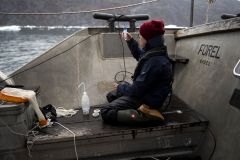GreenFjord focuses on a system with two types of fjord: one influenced by a "marine-terminating glacier" and the other by a "land-terminating glacier". In the former, freshwater from the ice enters the fjord directly into the water, whereas in the latter, water enters the fjord water via the land, often via a river. These two configurations have a major influence on the functioning of the ecosystem and the biodiversity that lives there. We are trying to understand and quantify this difference of biodiversity by carrying out environmental DNA (eDNA) sampling.
eDNA, what are we talking about?
All living beings, whatever their size or ecology, leave traces of DNA during their passage through the environment they frequent, via the loss of scales, hairs and secretions. Environmental DNA (eDNA) is a non-invasive biodiversity monitoring technique for natural environments and species. This approach is by definition non-invasive since individuals are not disturbed, only their traces are collected."To do this, we collect a quantity of water and filter it. Then we carry out an environmental DNA barcoding on the sample, which is a species identification method that uses a DNA sequence. This enables all the species present in the sample to be identified in a single operation. In this way, we can characterize the biodiversity present, from bacteria and plankton to fish and marine mammals, by amplifying their DNA." Virginie Marquez.
photo : @julien.girardot.photography




